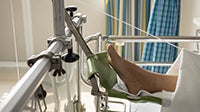Bone, Ligament & Joint Injuries
One of the most common injuries associated with traumatic incidents are bone, ligament and joint injuries — otherwise known as orthopedic trauma. While the vast majority of these injuries are minor and treatable, it is important for patients to be aware of potential complications and their overall course of recovery so that they may achieve the best outcomes.
Most common traumatic orthopedic injuries:
- Dislocation — when the bones on either side of a joint (i.e., a point of movement) do not correctly line up
- Fracture — broken bones
- Comminuted fracture — bone has broken into three or more pieces.
- Open fracture — pieces of bone stick out through the skin; these often take the longest to heal.
Management
Injuries to bone can be managed in a variety of ways both operatively (i.e., via surgery) or non-operatively. The type of management often depends on the type of injury, risk of further disability without surgery or stabilization, and characteristics of the patient (e.g., age, other illnesses, and injury severity) that may influence the risk of surgical management.
Types of Repairs
- Internal Fixation — The bone is first put back (reduced) into their normal position. Then metal implants (plates, rods, and screws) are placed on the surface or inside the bone to hold the bone together while the fracture heals.
 Skeletal traction — A pulley system of weights and counterweights that helps realign the pieces of bone. Often used in femur fractures to keep broken bone fragments in as normal of a position as possible.
Skeletal traction — A pulley system of weights and counterweights that helps realign the pieces of bone. Often used in femur fractures to keep broken bone fragments in as normal of a position as possible. - External Fixation — Hardware is placed on the outside of the injured limb. Usually used to stabilize bones in an open fracture.
- Reductions — Putting the joint back in its socket. In this situation, the patient is given mild sedation or pain medicine through an intravenous line and the physician will pull on joint until it is correctly aligned.
- Rib fractures — Rib fractures are most often treated with just rest, pulmonary therapy via breathing exercise, and pain control. In serious cases, such as when the rib splinters and injures the underlying lung, a procedure called rib plating can be performed to stabilize the ribs.
- Pelvic fractures — Pelvic injuries have the potential to cause bleeding and may need treatment with administration of a pelvic binder (i.e., a brace).
- Open fractures — Open fractures carry a larger risk of infection because the open wound can be exposed to outside contamination such as dirt and bacteria.
- Debridement and Irrigation — a procedure for open fractures that involves removing contaminated material and damaged tissue from the wound and then washed out with saline solution.
Patient Advocacy
A traumatic injury can be very scary and unfamiliar to navigate. The following are questions to ask your provider to be more informed about your treatment:
- The exact type of your injury
- The severity of the injury
- The treatment plan and if surgery is necessary immediately or later
- The possible complications
- Expectation of full recovery
- Short-term and long-term outcomes
What Recovery Looks Like
- Recovery from a traumatic bone injury often depends on the type and severity of fracture. Additionally, if you have any serious medical conditions such as diabetes or vascular disease, you may experience a longer healing time.
- Successful healing can be achieved with physical therapy, early movement when advised by provider, and sometimes vitamin supplementation.
Information adapted from the Mayo Foundation for Medical Research and Education.
